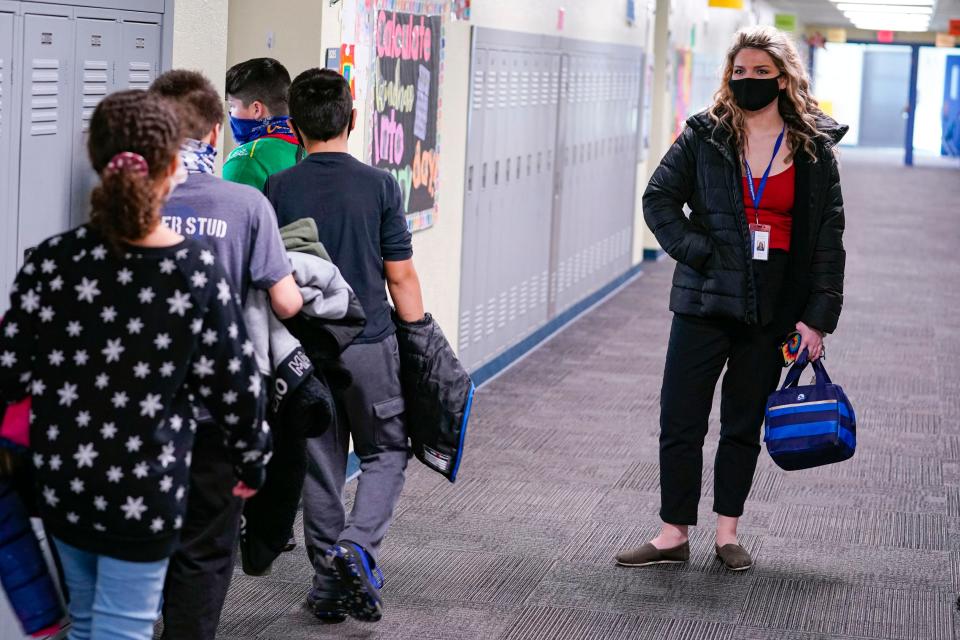Private and public sectors must collaborate on tests, shots, to keep K-12 schools open
Despite these perpetually fractious times, nearly everyone on the left and right agrees that COVID-19 has profoundly negative effects on our K-12 students. For students, school closures are associated with learning disruptions, social development issues and depression.
Closed schools affect parents, our economy and health care capacity as well. For those without child care options, it often means loss of hours, and even jobs, adding further stressors to household life. This can’t continue. All of us need to take what we’ve learned over the past couple of years and implement what we know works using the resources already allocated to turn this situation around.
To date, massive amounts of federal funding have been provided to address COVID's impact on education and learning. Two administrations – one under President Donald Trump and one under President Joe Biden – have repeatedly, and in a bipartisan manner, authorized billions of dollars in aid for K-12 remediation efforts.
Thousands of schools closed for in-person learning
Yet, today we find skyrocketing numbers of new cases in communities across the USA, and thousands of schools are closed for in-person learning.
In the American Rescue Plan, the federal government authorized $122 billion for Elementary and Secondary School Emergency Relief (ESSER), with 90% tied directly to local K-12 districts.
Former U.S. Surgeon General: I got it wrong on masks at the start of the pandemic. This is how we can get it right.
Disclosure requirement data is showing that of the more than $64 billion accounted for, covering more than 2,700 districts in over 45 states, less than 20% of districts have planned spending directly on COVID-19 mitigation.
Don't assume closures are inevitable
A significant amount went to ameliorating the effects of closures, though not preventing the closures in the first place: remote learning, tutoring, and afterschool and summer school programs.
These offerings try to address the problems for students after the fact; they assume closures are inevitable rather than treating the closures themselves as the events to be avoided.
In the early months of the pandemic, the focus on recovery and rehabilitation strategies were understandable. But as we enter this third year, we’ve had plenty of time and experience to know how to get this right. The Centers for Disease Control and Prevention and the Biden administration are coalescing around the most effective way to keep schools open, and that is by implementing "Test to Stay” protocols.
The World Health Organization: COVID-19 has shown sustainable financing of WHO is needed to deliver health for all
Here, in alignment with the CDC recommendations, students and staff are routinely tested if they have been directly exposed to those known to have COVID-19. Along the way, contact tracing is being conducted to track the movement of the virus. Those who test negative are allowed back into the classroom, while those who test positive start the timer on self-isolation.

This is a resource-intensive process and will require a massive increase in the availability of testing locations and home testing kits – to levels comparable to those in the United Kingdom and the European Union. There, testing is readily available and free in some countries for all who request them.
2 billion COVID tests a month
I believe we need up to 2 billion tests per month for the American public to fully embrace this critical public health tool. Building and encouraging a testing mindset will enable Americans to identify infections, and isolate themselves from the transmission pool and help keep schools and workplaces open. This effort will require significant staffing and resources, which can be addressed by drawing upon the federal government relief allocations already funded and on hand in state government coffers. Companies like mine, AM LLC, work with officials and agencies to help coordinate and administer large-scale testing operations.
But federal, state and local governments aren’t equipped to manage this new work themselves. The private sector, including the health care and the disease management industry, have already partnered with jurisdictions and governments around the country to help.
Dr. Marc Siegel: Isolating from a world filled with omicron makes less and less sense
Significant federal resources have been allocated so that those localities and K-12 districts that cannot conduct effective programs like Test to Stay with existing staff can hire experienced partners that can get the testing done – as well as provide vaccinations, contract tracing and advise all levels of government on best COVID mitigation practices.
As a society, we are again faced with making tough decisions that will have long-lasting consequences – especially over the struggle to keep our schools open – which Biden has vocally supported.
Keeping schools open must be our priority. We can do it safely and responsibly as we implement robust measures that will prevent more infections, deaths and closures. Reimagining how the public and private sectors come together to solve these public health challenges is the key to putting this pandemic behind us.
Dr. Robert R. Redfield Jr. is the senior medical adviser at AM LLC, a public health firm working with K-12 schools and federal, state and local health departments. He was the former director of the Centers for Disease Control and Prevention from 2018-21.
You can read diverse opinions from our Board of Contributors and other writers on the Opinion front page, on Twitter @usatodayopinion and in our daily Opinion newsletter. To respond to a column, submit a comment to letters@usatoday.com.
This article originally appeared on USA TODAY: Keeping schools open safely and responsibly must be our priority

